TYRES

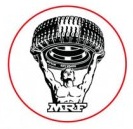
BATTERIES

UPS

SERVICES
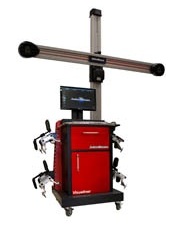


-: WHEEL ALIGNMENT AND BALANCING :-
 Wheel alignment and Wheel Balancing are two totally different things,
but many people often get them confused. In a nutshell, wheel alignment
consists of adjusting the angles of the wheels so that they are perpendicular
to the ground and parallel to each other. The purpose of these adjustments is
maximum tyre life and a vehicle that tracks straight and true when driving along
a straight and level road. Wheel Balancing, on the other hand allows the tyres
and wheels to spin without causing any vibrations. This is accomplished by checking
for any heavy spots on the wheel-tyre combination and compensating for it by placing
a measured lead weight on the opposite site of the wheel from where the heavy spot is.
Wheel alignment and Wheel Balancing are two totally different things,
but many people often get them confused. In a nutshell, wheel alignment
consists of adjusting the angles of the wheels so that they are perpendicular
to the ground and parallel to each other. The purpose of these adjustments is
maximum tyre life and a vehicle that tracks straight and true when driving along
a straight and level road. Wheel Balancing, on the other hand allows the tyres
and wheels to spin without causing any vibrations. This is accomplished by checking
for any heavy spots on the wheel-tyre combination and compensating for it by placing
a measured lead weight on the opposite site of the wheel from where the heavy spot is.
The symptoms of a car that is out of alignment are:
• Uneven or rapid tyre wear
• Pulling or drifting away from a straight line
• Wandering on a straight level road
• Spokes of the steering wheel off to one side
while driving on a straight and level road.
The symptoms of a wheel that is out of balance are:
• Vibration in the steering wheel at certain highway speeds.
• Vibration in the seat or floorboard at certain highway speeds.
• Scalloped or cupped wear pattern on the tyres
To find out if you need an alignment, first check each tyre and look for uneven wear patterns.
The problem with this method, however, is that if you can see a wear pattern like the ones
listed below, it may be too late to save that tyre. This is why it is a good idea to have
your alignment checked periodically.
At each tyre, take a coin and insert it in the tread at the inside, centre and outside.

If the tread is deeper on the edges than in the centre, the tyre is over inflated.

If the tread is deeper in the centre than the edges, the tyre is under inflated.

If the tread is deeper on one side than the other, have your wheel alignment checked soon.
 Run your hand back and forth across the tread, being careful not to cut yourself on any
debris or exposed steel belt wire. If the tread is smooth in one direction,
but jagged in the other you have what is called a "saw-tooth" wear pattern which
is caused by a toe-in problem. Have the alignment checked as soon as possible as
this condition causes rapid tyre wear.
Run your hand back and forth across the tread, being careful not to cut yourself on any
debris or exposed steel belt wire. If the tread is smooth in one direction,
but jagged in the other you have what is called a "saw-tooth" wear pattern which
is caused by a toe-in problem. Have the alignment checked as soon as possible as
this condition causes rapid tyre wear.
The first two conditions do not call for a wheel alignment but the second two do. If these
wear patterns are pronounced, you should replace the tyres or move them to the rear before
aligning the car. Ask your alignment specialist to be sure.
Another indication of an out-of-alignment condition is a car that continuously drifts or pulls
to one side of the road when you let go of the wheel. A car that is hard to keep in a straight
line without constant steering corrections is also a candidate. These conditions may or may not
also contribute to premature tyre wear.
A wheel alignment cannot be done on a car with loose or worn front end parts. The technician
will first check for worn parts and inform you of any problems before beginning the alignment.
The best type of wheel alignment is a our wheel alignment. Many cars today have adjustable
rear alignment settings, but even for cars without adjustments in the rear, a four wheel
alignment will allow the technician to identify any rear tracking problems and compensate for
them with adjustments to the front.
After the wheel alignment is finished, you should drive the car on a straight and level road
and check that the car goes straight and that thesteering wheel is in the proper position
with the spokes level. If you notice a problem,take the car back and have the technician
drive it and fine-tune the alignment settings.
Click Here for more information on Wheel Alignment
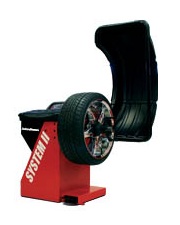 Out-of-balance tyres will cause a car to vibrate at certain speeds, usually between 50 and 70 mph.
A tyre is out of balance when one section of the tyre is heavier than the others. One ounce of
imbalance on a front tyre is enough to cause a noticeable vibration in the steering wheel at about
60mph. To balance a wheel, the technician will mount it on a balancing machine which spins the
wheel to locate the heavier part. He will then compensate for the heavy part by attaching a lead
weight on the opposite side. Many people are pleasantly surprised at how smooth their car drives
after balancing all four wheels.
Out-of-balance tyres will cause a car to vibrate at certain speeds, usually between 50 and 70 mph.
A tyre is out of balance when one section of the tyre is heavier than the others. One ounce of
imbalance on a front tyre is enough to cause a noticeable vibration in the steering wheel at about
60mph. To balance a wheel, the technician will mount it on a balancing machine which spins the
wheel to locate the heavier part. He will then compensate for the heavy part by attaching a lead
weight on the opposite side. Many people are pleasantly surprised at how smooth their car drives
after balancing all four wheels.
Most high quality tyres will hold their balance fairly well and go out of balance very gradually.
If you notice a vibration that wasn't there the day before, it is possible that one of the lead
balancing weights fell off. If you feel the vibration mostly in the steering wheel, the problem
is most likely in a front wheel. If the vibration is mostly in the seat, the problem is probably
in the rear.
For those of you who are very sensitive about vibrations and your shop can't seem to get that last
bit of vibration out, check to see if you have locking wheel lugs. Some locking lugs are as much
as 1.5 ounces heavier than the other lug nuts which translates to about 1/2 ounce at the wheel rim.
Try putting a 1/2 ounce weight opposite the locking lug and see if it helps.
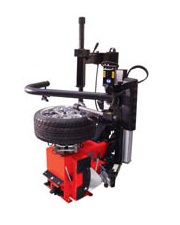 On front wheel drive cars, it is especially important to rotate your tyres periodically because
the front tyres wear faster than the rear. Uneven tyre tread thickness, front to rear, will give
you uneven braking and poor handling, especially in the rain. If you don't rotate the tyres,
you'll wind up replacing them two at the time, which means you'll always have uneven tread
thickness. Replacing tyres in a matched set of four will keep the handling and braking traction
of the car balanced.
On front wheel drive cars, it is especially important to rotate your tyres periodically because
the front tyres wear faster than the rear. Uneven tyre tread thickness, front to rear, will give
you uneven braking and poor handling, especially in the rain. If you don't rotate the tyres,
you'll wind up replacing them two at the time, which means you'll always have uneven tread
thickness. Replacing tyres in a matched set of four will keep the handling and braking traction
of the car balanced.
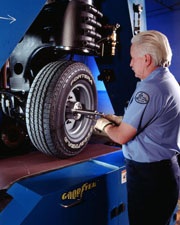 On certain cars, you may experience an additional problem when you do not rotate the tyres:
tyre noise or humming on smooth roads. If you notice a humming noise, check the rear tyres
for a "saw-tooth" wear pattern on the inside and outside shoulder of the tyre. You can detect
this by running your hand back and forth along the edges of the tyre tread. Be careful not to
cut yourself on debris or exposed steel belt wire. If it feels smooth in one direction,
but jagged in the other, you may have found some of your noise. This condition happens on
ome front wheel drive vehicles with tyres that have tread blocks on the shoulder of the tyre.
Rotating this tyre to the other side of the car should even out this type of wear and quiet down
the humming. Check your owner's manual for the proper rotation method. Most front wheel drive cars
require the following rotation method:
On certain cars, you may experience an additional problem when you do not rotate the tyres:
tyre noise or humming on smooth roads. If you notice a humming noise, check the rear tyres
for a "saw-tooth" wear pattern on the inside and outside shoulder of the tyre. You can detect
this by running your hand back and forth along the edges of the tyre tread. Be careful not to
cut yourself on debris or exposed steel belt wire. If it feels smooth in one direction,
but jagged in the other, you may have found some of your noise. This condition happens on
ome front wheel drive vehicles with tyres that have tread blocks on the shoulder of the tyre.
Rotating this tyre to the other side of the car should even out this type of wear and quiet down
the humming. Check your owner's manual for the proper rotation method. Most front wheel drive cars
require the following rotation method:
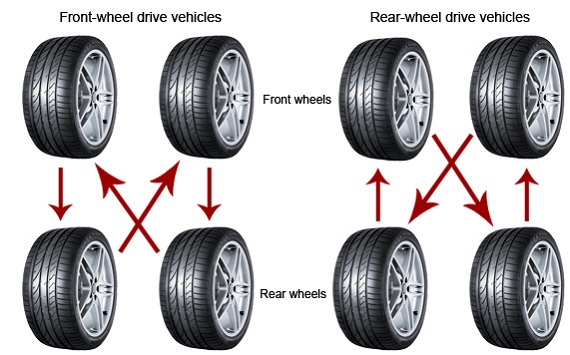
Tyre rotation
Warning: If you have directional tyres such as Goodyear Aquatreads they mustnever be crossed over to the other side of the car. You can tell by the fact that theywill have a clearly marked arrow on the sidewall showing the direction of rotation.
